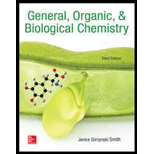
Concept explainers
(a)
Interpretation:
The
Concept introduction:
All types of organic molecules have their own specific type of functional group. Functional groups present in biological molecules play a major role in the formation of molecules such as carbohydrates, DNA, proteins and lipids. Functional groups can be named as carbonyl, hydroxyl, amino, methyl, sulfhydryl, phosphate, and carboxyl.
(b)
Interpretation:
The skeletal structure of PGE2 needs to be drawn.
Concept introduction:
Prostaglandin E2 (PGE2) is known to be naturally occurring and helps in medication. It is used in the labor induction, termination of pregnancy, bleeding after delivery and also in the newborn babies in order to keep the duct arteries open. In babies with congenital heart defects it is used until surgery is carried out. It may be injected into the vagina or vein.
Want to see the full answer?
Check out a sample textbook solution
Chapter 19 Solutions
General, Organic, & Biological Chemistry
- What is the meaning of the term tertiary (3) when it is used to classify alcohols? Draw a structural formula for the one tertiary (3) alcohol with the molecular formula C4H10O.arrow_forwardUnlike methanol, which is a nearly odorless liquid, methanethiol (CH3SH) is a gas with an appalling odor reminiscent of skunks. It is one of the compounds added to natural gas as a warning for gas leaks. Using appropriate drawing tools, draw the structure of methanethiol in such a way that there is double bond between carbon and sulfur.arrow_forward4: Draw out the abbreviated structural formula of the following molecules. 4-Methyl-2-hexene 2-Methyl-2-hexene 2-Hexene 5: Draw the structure of 2-Butene, labeling the n bond and all the B bonds. 6: Draw all the structures possible with the formula CSH8.arrow_forward
- Draw the cis and trans isomers of 2-butene, CH3CHCHCH₂. Show all hydrogen atoms. cis-2-butene Incorrect Y trans-2-butene Incorrect YA Harrow_forwardWith reference to organic molecules, explain the following structure: CH2 CH— О CH2arrow_forwardDraw the condensed structure of an isomer of this molecule: HỌ—C—CH2−CH2—C—H Click anywhere to draw the first atom of your structure.arrow_forward
- Consider the compound C₂H₃N. Which one of the structures in Figure 4 is the best representation of this compound based on your current knowledge? * 1 - A 2- B 3 - C 4- D 5 - All these structures are good representations of the compound.arrow_forward= ORGANIC CHEMISTRY Drawing a skeletal structure from a condensed structure Draw a skeletal ("line") structure of this molecule: OH CH3 -C-CH₂-CH=CH₂ OHarrow_forwardA. Structural Isomerism of Alkanes Construct models for the five alkanes that have the molecular formula C6H14. All five of your models should have the same number of each type of atom, but they should have the atoms connected in a different order. Thus the molecules they represent are structural isomers of one another. Note the tetrahedral geometry of each carbon atom. Draw an extended and a condensed structure (NOT skeletal/line angle) of each structural isomer, then determine its IUPAC name. Recall that since the IUPAC name specifies the number of each type of atom and how they are connected, each structural isomer will have a different name. Each name should very specifically describe the structure. Isomer 1: Extended Structure Isomer 1: Condensed Structure IUPAC Name: IUPAC Name: Isomer 2: Extended Structure Isomer 2: Condensed Structurearrow_forward
- 0 hn. Ch3 oh. What is this formula molecular structure, number of carbon sites how many hydrogen sites how many atoms each How many atoms in each type of atom in the structure give a molecular formula and identify tw functional grarrow_forwardDraw the Lewis Structure 1. CH3CHOHCH3, isopropyl alcohol 2. CH3CH2CH2CO2H, butyric acid 3. CH3COOCH2CH3, ethyl acetatearrow_forwardDraw the skeletal structure of pentanal from the Lewis structure (shown below). Η Η Η Η :Ο: H—C-C-C-C-C-H Η Η Η Η Το 0arrow_forward
 Introductory Chemistry: A FoundationChemistryISBN:9781337399425Author:Steven S. Zumdahl, Donald J. DeCostePublisher:Cengage Learning
Introductory Chemistry: A FoundationChemistryISBN:9781337399425Author:Steven S. Zumdahl, Donald J. DeCostePublisher:Cengage Learning Chemistry & Chemical ReactivityChemistryISBN:9781337399074Author:John C. Kotz, Paul M. Treichel, John Townsend, David TreichelPublisher:Cengage Learning
Chemistry & Chemical ReactivityChemistryISBN:9781337399074Author:John C. Kotz, Paul M. Treichel, John Townsend, David TreichelPublisher:Cengage Learning Organic ChemistryChemistryISBN:9781305580350Author:William H. Brown, Brent L. Iverson, Eric Anslyn, Christopher S. FootePublisher:Cengage Learning
Organic ChemistryChemistryISBN:9781305580350Author:William H. Brown, Brent L. Iverson, Eric Anslyn, Christopher S. FootePublisher:Cengage Learning


